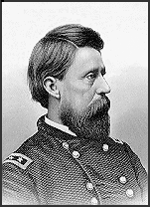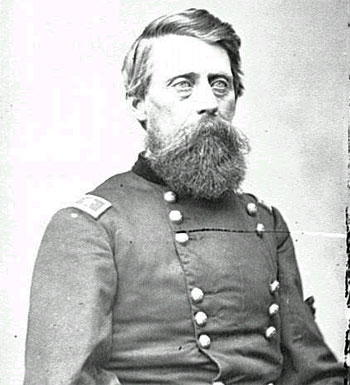Jefferson Columbus Davis
Jefferson Davis was born, the oldest of eight children, on a farm in Clark County, Indiana, on March 2, 1828.
He began his military career as an enlisted man in the 3rd Indiana Regiment during the Mexican War, and was promoted to Lieutenant of the 1st Artillery after the Battle of Buena Vista in 1848.
He was posted to Fort Sumter, South Carolina, in 1858, and was there in April of 1861 when the South began its 34-hour bombardment of Fort Sumter, often thought to be the first battle of the American Civil War.
 He was promoted to Captain in May of that year, but left his regular army position to accept the command of the 22nd Indiana Volunteer Infantry Regiment at the rank of Colonel. He was promoted to Captain in May of that year, but left his regular army position to accept the command of the 22nd Indiana Volunteer Infantry Regiment at the rank of Colonel.
In August, the 22nd Indiana was sent to confront the Confederates in the interior of Missouri. The following March, he contributed greatly to the Union victory at the Battle of Pea Ridge, Arkansas, while in command of a division. As a result, he was promoted to Brig. General of U.S. Volunteers in May of 1862, his commission backdated to the previous December.
He participated in Henry Halleck’s siege of Corinth, Mississippi.
In September of 1862, Davis quarreled with his superior officer, William Nelson. As a result, Davis shot and killed Nelson. No charges were filed in the case, as the Governor of Indiana came to his defense.
 Davis was returned to active duty, and participated in the Battle of Stones River near Murfreesboro, Tennessee. He performed extremely well at Chickamauga, Georgia, in September 1863, and the following summer he was Division Commander in Sherman’s Atlanta campaign. Moving to command the XIV Corps, Davis marched with Sherman to Savannah, Georgia, and northward into the Carolinas. Davis was returned to active duty, and participated in the Battle of Stones River near Murfreesboro, Tennessee. He performed extremely well at Chickamauga, Georgia, in September 1863, and the following summer he was Division Commander in Sherman’s Atlanta campaign. Moving to command the XIV Corps, Davis marched with Sherman to Savannah, Georgia, and northward into the Carolinas.
Perhaps due to the shooting of his commanding officer in 1862, he was never promoted to Major General, although he received five brevet commissions.
After the war, Davis was reverted to Colonel of the Infantry, and served for a time in Alaska. He also led U.S. troops against the Modoc Indians in retribution for the killing of Edward Richard Sprigg Canby.
He was still in the service of his country when he died on November 30, 1879.
|

